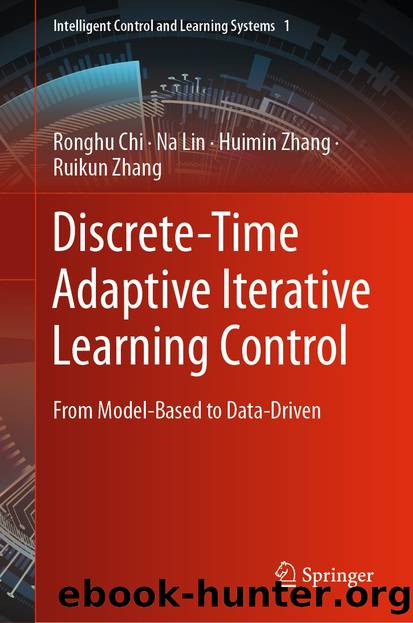Discrete-Time Adaptive Iterative Learning Control by Ronghu Chi & Na Lin & Huimin Zhang & Ruikun Zhang

Author:Ronghu Chi & Na Lin & Huimin Zhang & Ruikun Zhang
Language: eng
Format: epub
ISBN: 9789811904646
Publisher: Springer Singapore
(2)College of Mathematics and Physics, Qingdao University of Science and Technology, Qingdao, China
Ronghu Chi (Corresponding author)
Email: [email protected]
Na Lin
Email: [email protected]
Huimin Zhang
Email: [email protected]
Ruikun Zhang
Email: [email protected]
6.1 Introduction
Distributed control that aims for consensus tasks of multi-agent systems has progressed rapidly with a wide range of applications (Olfati-Saber et al. 2007; Oh et al. 2015; Poveda et al. 2019). Moreover, consensus methods (Jadbabaie et al. 2003; Ren and Beard 2005; Cao et al. 2008; Zhang et al. 2012; Rezaee and Abdollahi 2019; Hua et al. 2020) have attracted numerous attentions as the fundamental and popular problems of distributed control. However, most of these results focus on the protocol design with asymptotic convergence for output consensus when the operation time approaches infinity. In contrast, many systems operate repetitively over a finite duration. For example, the heating, ventilation and air conditioning (HVAC) system of a commercial building works repetitively day after day, or week after week, where the working hours, room temperature, and human activities are all repeatable to a certain degree. For such a finite-time consensus, transient response is most important to ensure a good consensus performance.
Due to the learning ability from control experience, ILC is a excellent method to improve transient response over finite duration. Therefore, many works have been developed in combining consensus control and ILC algorithms. For example, some adaptive ILC consensus methods have been proposed for MASs, where the linear parametric systems (Shen and Xu 2017; Yang et al. 2015; Li and Li 2013), higher order systems (Li and Li 2014; Shen and Xu 2018; Jin 2016), nonlinear parametric systems (Wu and Li 2019; Wu et al. 2018), and nonlinear affine systems (Shen et al. 2019; Li and Li 2014, 2015) are all considered. However, there still exist some challenging problems that impede the extensive applications of these AILC consensus methods.
First, most of these AILC consensus methods (Shen and Xu 2017; Yang et al. 2015; Li and Li 2013, 2014; Shen and Xu 2018; Shen et al. 2019; Li and Li 2015) require identical initial condition as that in the traditional adaptive ILC methods. Second, all the AILC consensus protocols (Shen and Xu 2017; Yang et al. 2015; Li and Li 2013, 2014; Shen and Xu 2018; Jin 2016; Wu and Li 2019; Wu et al. 2018; Shen et al. 2019; Li and Li 2014, 2015) depend on a fundamental requirement that the reference trajectories (or virtual leaders) be strictly repetitive, which greatly limits their practical applications because the desired trajectory often varies with different operations. Continuing the HVAC system of a building as an example, the expected setting temperature of the room may vary every day owing to occupantâs preferences. Third, it is worth mentioning that the AILC consensus protocols (Shen and Xu 2017; Yang et al. 2015; Li and Li 2013, 2014; Shen and Xu 2018; Jin 2016; Wu and Li 2019; Wu et al. 2018; Shen et al. 2019; Li and Li 2014, 2015; Li et al. 2015; Chen et al. 2019) all aim at continuous-time MASs. No related researches have been conducted for discrete-time systems due to fewer mathematical tools available.
Download
This site does not store any files on its server. We only index and link to content provided by other sites. Please contact the content providers to delete copyright contents if any and email us, we'll remove relevant links or contents immediately.
Management Strategies for the Cloud Revolution: How Cloud Computing Is Transforming Business and Why You Can't Afford to Be Left Behind by Charles Babcock(4130)
Ego Is the Enemy by Ryan Holiday(3991)
Offensive Shellcode from Scratch by Rishalin Pillay(3666)
Exploring Deepfakes by Bryan Lyon and Matt Tora(3250)
Robo-Advisor with Python by Aki Ranin(3028)
Learning C# by Developing Games with Unity 2021 by Harrison Ferrone(2871)
Speed Up Your Python with Rust by Maxwell Flitton(2849)
Liar's Poker by Michael Lewis(2811)
Agile Security Operations by Hinne Hettema(2804)
Linux Command Line and Shell Scripting Techniques by Vedran Dakic and Jasmin Redzepagic(2803)
OPNsense Beginner to Professional by Julio Cesar Bueno de Camargo(2802)
Extreme DAX by Michiel Rozema & Henk Vlootman(2790)
Essential Cryptography for JavaScript Developers by Alessandro Segala(2740)
Elevating React Web Development with Gatsby by Samuel Larsen-Disney(2729)
Python for ArcGIS Pro by Silas Toms Bill Parker(2644)
AI-Powered Commerce by Andy Pandharikar & Frederik Bussler(2642)
Cryptography Algorithms by Massimo Bertaccini(2627)
Incident Response Techniques for Ransomware Attacks by Oleg Skulkin(2626)
Distributed .NET with Microsoft Orleans by Bhupesh Guptha Muthiyalu Suneel Kumar Kunani(2625)
